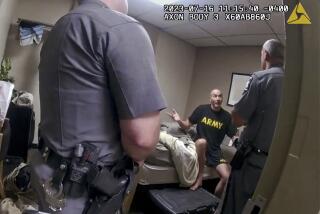Life after brain injuries
- Share via
In 1848, a worksite explosion thrust a 13-pound iron pole through the cheek and into the prefrontal cortex of Phineas Gage, a railway construction foreman working in Vermont. The pole, more than an inch thick, rocketed through his skull with such force that it landed 30 yards away, smeared with blood and brain matter.
Minutes after the accident, Gage was conscious and walking. After battling infections, he was reported to have recovered completely. A later clinical account, however, noted that the once-judicious and reliable worker had become an impulsive, bad-tempered ne’er-do-well whose “friends and acquaintances said he was ‘no longer Gage.’”
One of the earliest well-documented cases of survival from penetrating brain injury, Phineas Gage’s story underscores a mysterious contradiction. Sometimes in the wake of injury, the brain rallies to perform its major functions so well that the patient seems altogether recovered: Like Gage, he walks, speaks sensibly and understands what others say.
But somewhere in that 3-pound jumble of cells, that same injury can rob him of subtle abilities that make human beings such uniquely adaptive, self-aware and social creatures.
When healthy, the human brain is capable of such evolutionary wonders as abstract thought, moral judgment, attention to complex social conventions and memories that conjure up the full sense of an event.
But this brain is poised between delicacy and resilience, weakness and strength.
Where major functions have been compromised by injury or disease — for instance, if a person has lost depth perception or mobility on one side of the body — electrical signals will sometimes reroute themselves through unhurt brain structures to bring those capabilities back online.
Unharmed senses, such as hearing or touch, can become sharper to pick up slack for an ability that’s been lost or compromised. A patient can learn new strategies — say, the use of a cane or techniques to gauge an object’s distance — to compensate for an impairment.
This is the brain’s strength. Scientists call it plasticity, referring to the brain’s ability to reshape itself to adapt to changed circumstances.
But emerging research is also revealing that the capabilities that make us so mentally agile and socially attuned are distributed widely. Distinct clusters of neurons, often distant from each other but wired together, have evolved to cooperate seamlessly, as networks. These networks allow us to retrieve memories that are rich with meaning, to reflect upon and learn from our own personal histories, to pay rapt attention when we need to and to multitask when we don’t.
If we are to perform such complex behavior well, each node of those networks, and all the links between them, must be up and running. Therein lies the brain’s weakness.
If injury or disease creates a remote outage within the network that allows us to make and store memories, a person may no longer be able to conjure up memories with their usual richness or make new ones that “stick.” Damage within the network that helps us focus or shift our attention can make a person impulsive or unable to do two simple tasks at the same time.
Neuroscientist Jordan Grafman, lead researcher on a 41-year study of U.S. troops who sustained penetrating brain injury in Vietnam, recalls a veteran not unlike Gage. He was a model soldier who would climb into tunnels and bunkers to flush out the enemy. During an ambush, a chunk of shrapnel tore into his brain and lodged in his ventromedial prefrontal cortex, just behind his eyes. This area appears to serve as a switchboard for signals that bear on the subtle conventions of social behavior — signals that originate in structures scattered through the brain.
The soldier survived and, appearing to have recovered fully, was sent stateside to train recruits. But there his dependable manner gave way to impulsive and unwise behavior. He gave money to anyone who asked, married a prostitute and was erratic in showing up for work and paying bills. In the end, he could, with difficulty, hold down a menial job.
“People can have relatively selective problems in social behavior, even when intellectual functioning is preserved,” Grafman says. These are crucial impairments that can stunt a survivor’s recovery. By contrast, if injury leaves these social skills intact, a survivor is far better equipped to learn and exercise strategies to compensate for seemingly worse impairments, such as paralysis or loss of vision or hearing.







